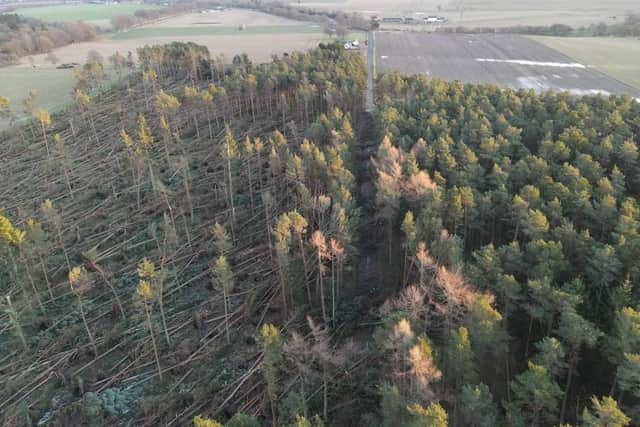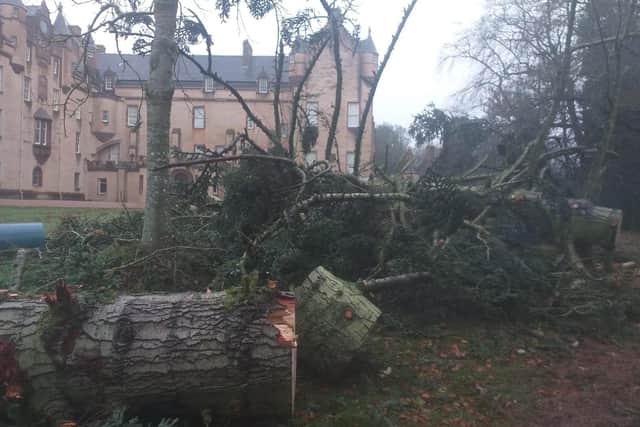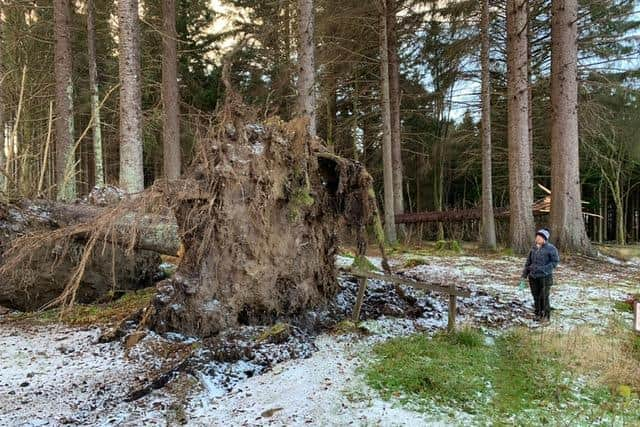Storm Barra: Danger warnings as more trees expected to fall as Barra sweeps in after deadly Storm Arwen
And there are fears many more trees could be brought down as the new Storm Barra sweeps in today, bringing further gales to parts of the country that are still recovering.
Storm Arwen, which hit on November 26, saw the east coast of the country battered by winds reaching up to 100mph.
Advertisement
Hide AdAdvertisement
Hide AdRoads and railways were blocked, power lines brought down and huge swathes of woodlands left flattened by the gale-force winds.


Three people died during the storm, including a man in Aberdeenshire whose vehicle was struck by a falling tree.
Now forecasters are predicting winds could reach 70mph to 80mph in some coastal areas today as Storm Barra strikes.
Although not as fierce as its predecessor, many more trees could come down as a result of ground being loosened, roots undermined and previously sheltered areas left exposed after Storm Arwen.
An added danger comes from trees which were taken down in the previous storm, but have not yet hit the ground, remaining precariously propped up by their neighbours.


Members of the public are being warned to stay clear of forests until clear-up operations have been completed.
The Great Storm of 1987, the UK’s most devastating since 1703, killed 18 people and caused mass destruction in the south of England in October 1987.
In excess of £1 billion of damage was caused and trees covering more than one million cubic metres were torn down in its wake.
Advertisement
Hide AdAdvertisement
Hide Ad

The full extent of the damage from Storm Arwen is yet to be tallied up, but industry experts are estimating that up to 1.5 million cubic metres of trees may have been felled across Scotland, mainly in plantations grown for timber.
If the estimate is accurate, losses will be in excess of one million cubic metres – the trigger level for a ‘catastrophic wind blow’ classification.
Scotland was previously struck by such events in 1953 and 1968.
‘Before’ and ‘after’ photographs taken from space will be used for the first time to help quantify the scale of losses in a cutting-edge project led by national scientific agency Forest Research.
Jamie Farquhar, national manager for Scotland at forestry and wood trade body Confor, said: “The best current estimate is that between one and 1.5 million cubic metres of timber has been brought down by the storm.
“This represents about 20 per cent of timber harvested annually in Scotland.
“However, many of the forests affected are hard to access and we won’t have a full picture until Forest Research can complete its analysis of satellite images in the coming days.”
Aberdeenshire and the Scottish Borders were the worst hit parts of Scotland, but other areas, including East Lothian, Perthshire, Angus and Dumfriesshire, were also badly affected.
Advertisement
Hide AdAdvertisement
Hide AdHaddo House and Country Park in Aberdeenshire has been amongst the worst-affected properties, with as many as half a million trees lost on the wider estate.
The National Trust for Scotland has reported that some of its sites have lost as much as 70 per cent of their entire tree cover, including some specimens that were more than 100 years old.
“Our teams in the north-east and the Borders have been working flat out in the aftermath of Storm Arwen,” a spokesperson for the conservation charity said.
“The first priority, as always, has been to ensure the safety of the public and our workforce and then conduct a full assessment of the damage to the places we care for.
“The most significant level of damage has been to woodlands and forestry in the north-east especially.
“The worst affected locations include the estates around Fyvie, Crathes and Drum castles, with the loss of some of the largest trees that edged the driveways, which pulled up tarmac as they fell, and the loss of several trees that were 100 years old and older.
“There has been structural damage to several buildings too.
“Our surveyors are still at work and it may be some time before the full extent of damage is confirmed.
“We’re well-aware of the impending Storm Barra and are concerned that further damage may occur, given the saturated ground conditions and the loss of so much tree cover that would have provided some screening.
Advertisement
Hide AdAdvertisement
Hide Ad“We’ll be working hard to repair the historic buildings in our care, but it will take much effort and many years to restore the affected woodlands, and we have launched an appeal to help raise funds to help us do this.”
Despite the enormous number of trees brought down by the storm, the losses should not negatively affect Scotland’s environmental performance and recovery should be swift.
Doug Howieson is head of operational delivery for Scottish Forestry, the government agency responsible for regulation and policy support for all woodlands in Scotland.
He is staying in temporary accommodation because his own home remains without heat and power in the aftermath of Storm Arwen.
“The natural world is wonderfully dynamic,” he said.
“Within a few months nature will begin its recovery, with new seeds germinating in the soil and starting to spring up.
“It may take 50 to 70 years for these to reach the size of the trees that were blown down, because these were mature, but in terms of Scotland’s natural world, things will look very different in a year’s time.
“Some of the felled trees will be left on the ground to rot, providing valuable habitats for wildlife, while others will be collected and used for timber.
“One of the features of this storm is that many of the felled trees were blown over rather than snapped off so they’re still alive.
Advertisement
Hide AdAdvertisement
Hide Ad“That means they can be harvested and utilised for timber if collected within the next few months.”
Scottish Forestry is working alongside councils, landowners, safety groups, contractors, processors and hauliers to co-ordinate clear-up operations and fast-track approvals to remove fallen trees.
Mr Farquhar, said the economic impacts on the forestry sector were likely to be “largely short-term, but potentially significant”.
“Species like Scots pine degrade quickly after windblow and trees that have snapped rather than completely blown over will have little or no value if they are not harvested quickly,” he said.
“Confor is engaging with Scottish Forestry to ensure that applications for felling permissions to clear windblown trees are processed quickly – to enable the wood supply chain to implement harvesting and marketing plans that will ensure that the windblown trees are harvested before they degrade and lose economic value.
“To achieve this goal it is important that Scottish Forestry is adequately resourced – in terms of both people and funding – to deal speedily with these applications and the backlog of normal business.
“A further challenge will be a shortage of skilled machine operators to remove wind blown trees.
“Confor will work closely with all parties to try to address all these problems in a structured way.”
A message from the Editor:
Thank you for reading this article. We’re more reliant on your support than ever as the shift in consumer habits brought about by coronavirus impacts our advertisers.
If you haven’t already, please consider supporting our trusted, fact-checked journalism by taking out a digital subscription.
Comments
Want to join the conversation? Please or to comment on this article.
